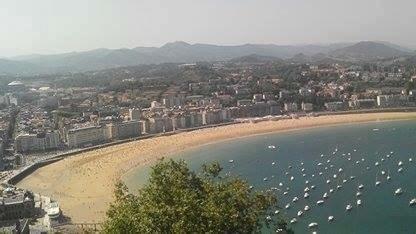
2 minute read
SAN SEBASTIÁN: CULTURE CAPITAL By Billy Proudlock

Donosti’s time has finally come. Since taking part in a school exchange many years ago, I’ve been well aware that this beautiful seaside city had been chosen to be a European Capital of Culture for 2016. My exchange partner and his teachers proudly reminded us of this fact with their constant wearing of “Donostia 2016” tshirts and stressing that I must visit again in 2016. Previous European Capitals of Culture have included the easily forgettable Mons, Umea and Kosice. The award has often been greeted with derision in England (see Hull’s recent nomination) but to the Donostiarras, this is their moment to showcase their vibrant, Basque city.
Advertisement
Set on the northern Spanish coast 15km from the French border and focused around 3 beaches, Donosti is a gloriously proud city. After one walk along the Boulevard, it would be impossible not to know that this is a European Capital of Culture. Posters and signs are prominently displayed in shop windows and every public building. To the Basque population, it's their chance to show Europe what being Basque entails. Beyond Spain, the Basque Country and its 3 million people are not well-known; its capital city Donosti even less so. One reason for its being unspoilt is its lack of an international airport. Easyjet, British Airways and Vueling all fly regularly from London to the less aesthetically-pleasing Bilbao, where most people choose to stay (one hour from Donosti). Donosti is statistically the most expensive city for living in Spain (in terms of € per m 2) and until last year held the record for most Michelin stars per capita in a city. Don’t let these things frighten your student mind or wallet. The high number of Michelin-starred restaurants ensures that less-acclaimed neighbouring restaurants maintain high standards. Stroll through the Parte Vieja any given lunch time and enjoy quality meals for no more than €15. Mention Donosti to anyone from the Iberian peninsula and their instant reaction will be to talk about food. The old town is littered with bars and cafes which serve beautifully hand-crafted pintxos (Basque tapas). Typically served on a small piece of bread delicately stacked with meat (amongst other things), pintxos are why foodies come to the Basque Country. The old town is famous for its pintxos but on Thursdays just across the bridge, Gros is the place to be. A couple of years ago bar owners in Gros launched “Pintxo-Pote” (literally ‘snack and drink’) whereby bars would sell a drink and selected pintxos for €2. Needless to say, Thursday is the night that the city comes to life – no matter the weather or time of year.
This small city of just over 100,000 people boasts three beaches. Mountains with incredible views overlook them and make for a rewarding climb. Museums detailing the Basque history and struggle are dotted around the city – those in the old town are particularly noteworthy and free on certain days. Indulge yourself in a trip to a cider house where you can gorge on steaks while pouring unlimited cider straight from the barrel. Get lost in the old town and its maze of streets with independent shops, supported by the local government opposed to chain stores (no Starbucks). Take in a football match at Anoeta stadium. Rent a surfboard at one of Europe’s best surfing beaches. Discover the famous international film festival in September. Witness strange forms of animal herding. Listen to improvised poetry slams (bertsolaritza). Gaze endlessly over the bay from the top of the mountains.
2016 European Capital of Culture or not, Donostia-San Sebastián is a breath-taking city waiting to be discovered.









